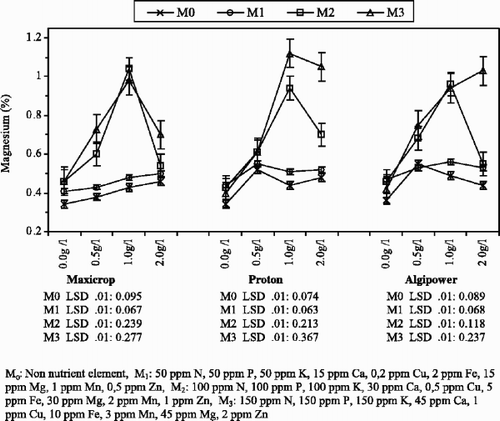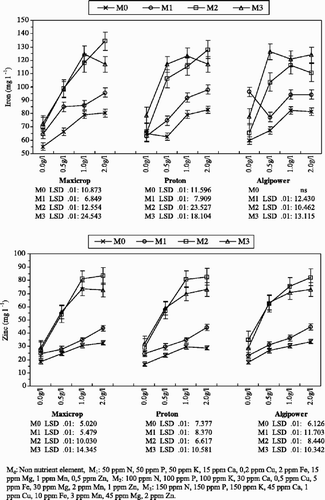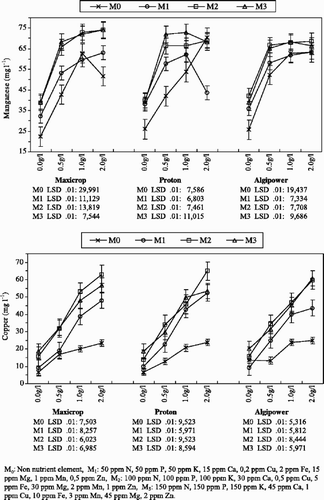Abstract
The objective of this study was to determine the effect of seaweed extract on macro and micro nutrient uptake of grapevine (Vitis vinifera L. cv. Karaerik). One-year-old grapevine (Vitis vinifera L. cv. Karaerik) saplings were planted in perlite with different nutrient element levels under greenhouse conditions. Three seaweed extracts, Maxicrop, Proton and Algipower, were sprayed on the foliage at different concentrations (0, 0.5, 1.0 and 2.0 g l−1). Results indicated that foliar application of seaweed extract increased Cu uptake of grapevine in the growth media which had insufficient nutrient elements. No significant differences in nutrient uptake of grapevine were obtained among the three seaweed extract types. The results showed that nutrient element level of growth media was more effective on stimulation of N, P, K, Ca, Fe, Mg, Mn and Zn uptake than seaweed extracts. In contrast, seaweed extract was more effective in supporting Cu uptake in vines than nutrient element level of growth media.
Introduction
Application of seaweed extract as an organic biostimulant is fast becoming an accepted practice in horticulture due to its beneficial effects (Verkleij, Citation1992). A wide range of these effects including increased crop yield, uptake of inorganic constituents from the soil, resistance of plants to frost and stress conditions, reduced incidence of fungal and insect attack, fewer storage losses of fruit, improved seed germination and increased crop quality have been reported from previous studies (Berlyn & Russo, Citation1990). Seaweed extract, being organic and biodegradable, is important in sustainable agriculture (Cassan et al., Citation1992), and use of seaweed products in organic farming has widely increased (Rader et al., Citation1985; Russo & Beryln, Citation1990). However, Csizinsky (Citation1994a) reported that seaweed extract spray had no beneficial effects on plants at all, and the results obtained could not be repeated according to season, crop, application methods, environmental and stress conditions (Blunden & Wildgoose, Citation1977; Gupta & MacLeod, Citation1982; Villers et al., Citation1983; Temple et al., Citation1989; Csizinsky, Citation1994b).
Miller (Citation1996) reported that seaweed had high quantities of amino acids. According to Abetz (Citation1980) it was clear that the mineral content of seaweed was not sufficient to affect plant growth by application of seaweed extracts.
Algae possess a high metal binding capacity whereby the cell wall plays an important role (Kuyucak & Volesky, Citation1989). Some researchers have also reported that seaweed extracts increase nutrient element uptake of plant under stress and nutrient element deficient conditions (Heckman, Citation1994; Crouch & Van Staden, Citation1994). Crouch et al. (Citation1990) demonstrated that seaweed extracts had beneficial effects on ion uptake in optimal conditions.
Kotze & Joubert (Citation1980) reported that Ecklonia maxima foliar sprays on Brassica oleraceae increased Ca uptake. Villiers et al. (Citation1983) reported that foliar application of Agral on apple increased Mn uptake but decreased Zn uptake. In contrast, it was reported that Agral application had no effects on nutrient element uptake on grapevine in the same study.
This study was undertaken to determine the effects of seaweed extracts on plant nutrient element uptake of grapevine from different nutrient element conditions.
Materials and methods
The experiment was conducted with one-year-old grapevine (Vitis vinifera L. cv. Karaerik) saplings and carried out in perlite in 20 cm diameter polyethylene pots, one vine per pot. Four different levels of nutrient elements as a basic fertilizer were applied in the perlite as follows:
| 1. | M0: non-nutrient element; | ||||
| 2. | M1: 50 ppm N, 50 ppm P, 50 ppm K, 15 ppm Ca, 0.2 ppm Cu, 2 ppm Fe, 15 ppm Mg, 1 ppm Mn, 0.5 ppm Zn; | ||||
| 3. | M2: 100 ppm N, 100 ppm P, 100 ppm K, 30 ppm Ca, 0.5 ppm Cu, 5 ppm Fe, 30 ppm Mg, 2 ppm Mn, 1 ppm Zn; | ||||
| 4. | M3: 150 ppm N, 150 ppm P, 150 ppm K, 45 ppm Ca, 1 ppm Cu, 10 ppm Fe, 45 ppm Mg, 3 ppm Mn, 2 ppm Zn. | ||||
For analysis of mineral uptake, all first mature leaves with petioles were chosen (not randomly) per plant (Marschner, Citation1995) three months after the first seaweed extract application. Total nitrogen was determined by the micro-Kjeldahl method; P by Vanadomolibdo yellow-colour method spectrophotometrically; and after plant samples were wet-fired with nitric-perchloric acid, K, Ca, Cu, Fe, Mg, Mn, and Zn analyses were determined using atomic absorption spectrophotometry (AOAC, Citation1970).
Each pot was considered as a replicate and all of the treatments were repeated three times. All data were subjected to a two-way analysis of variance (ANOVA) and separations by LSD were performed using (SAS) statistical software (SAS Citation1982).
Results and discussion
Macro nutrient uptake
Effects of seaweed extract applications and growth media nutrient element levels on supporting macro element uptake in vine were statistically significant. We found that applying seaweed extracts did not stimulate nutrient uptake in vines apart from N, P, K, Ca and Mg uptake in leaves (). With these elements the mineral uptake increased with increased concentration of extracts. The highest N and Ca contents of leaves were obtained from seaweed extract applications at 1.0 g l−1 concentration in growth media with optimum (M2) nutrient element levels (). The highest P, K and Mg contents of leaves were achieved when using seaweed extract applications at a level of 1.0 g l−1 concentration, in growth media with higher (M3) nutrient element levels ( and ). Our results showed that there were no effects of seaweed extracts on macro element uptake during nutrient stress conditions, but seaweed extracts had important effects on macro element uptake of grapevine at optimum (M2) or higher (M3) nutrient element conditions ().
Fig. 1. Effects of seaweed extract applied at different doses on nitrogen and calcium contents of leaves.
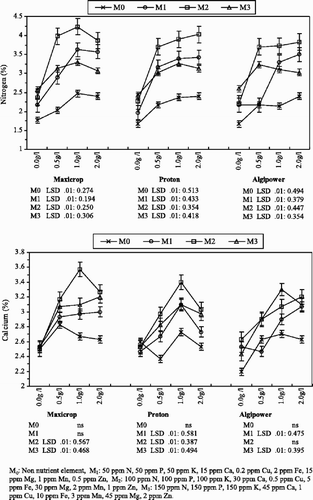
Fig. 2. Effects of seaweed extract applied at different doses on phosphorus and potassium contents of leaves.
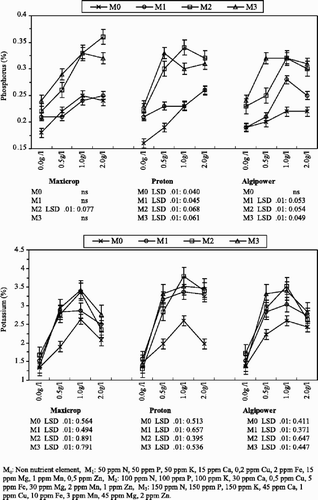
Table 1. ANOVA for macro and micro element contents of vine leaves including interactions
Table 2. LSD test result for means values of macro and micro element contents of grapevine leaves in different growth media
Our results confirm previous reports by Crouch et al. (Citation1990) who noted that in nutrient element deficient conditions, seaweed extracts had no effect on ion uptake of lettuce, but at optimum nutrition levels of Mg, K and Ca, uptake increased notably by lettuce. Also Kotze & Joubert (Citation1980) and Nelson & Van Staden (Citation1984) had similar findings to our results.
Micro nutrient uptake
With regard to micro element uptakes, seaweed extract improved uptake by the vines. Our results also showed that no differences in stimulating micro element uptake among the seaweed extract types occurred.
Iron plant uptake was stimulated using seaweed extract applications at 2.0 g l−1 concentration and growth media with a higher nutrient element level (M3). Zn uptake of grapevine was highest using a seaweed extract application of 2.0 g l−1 concentration and optimum (M2) nutrient element conditions (). Mn uptake was highest at optimum nutrient element conditions (M2) and 2.0 g l−1 seaweed extract application. The effectiveness of seaweed extracts on Cu uptake was higher than growth media nutrient element levels (). Influences of seaweed extracts on Cu uptake could be due to increasing membrane permeability of roots, leaves and stoma cells, and hormone-like activities of the seaweed extract through their involvement in cell respiration, photosynthesis, and various enzymatic reactions (Guiry & Blunden, Citation1991; Verkleij, Citation1992).
Conclusion
Seaweed extracts increase N, P, K, Ca, Cu, Fe, Mg, Mn and Zn uptake at optimum nutrient element conditions, while at limited nutrient levels in plant growth media seaweed extracts improve only Cu uptake. Seaweed extracts are recommended for use in vine cultivation on soils of with low or adequate nutrient elemental levels, since its use improves mineral uptake.
Additional information
Notes on contributors
Metin Turan
Turan, M. and Köse, C. (Soil Department, and Horticulture Department, Agriculture Faculty, Atatürk University, TR-25240 Erzurum, Turkey). Seaweed extracts improve copper uptake of grapevine. Accepted April 7, 2004.Notes
Turan, M. and Köse, C. (Soil Department, and Horticulture Department, Agriculture Faculty, Atatürk University, TR-25240 Erzurum, Turkey). Seaweed extracts improve copper uptake of grapevine. Accepted April 7, 2004.
References
References
- AOAC 1970 Official Methods of Analysis. Association of Official Agricultural Chemists Benjamin Franklin St., Washington USA
- Abertz , P . 1980 . Seaweed extracts: have they a place in Australian agriculture or horticulture? . J. Aust. Inst. Agric. Sci. , 46 : 23 – 29 .
- Albregts , EE , Howard , CM and Chander , C . 1988 . Effect of biostimulants on fruiting of strawberry . Proc. Fla. State Hort. Soc. , 101 : 370 – 372 .
- Beryln , GP and Russo , RO . 1990 . The use of organic biostimulants in nitrogen fixing trees . Nitrogen Fixing Trees Research Report , 81 : 1 – 2 .
- Blunden , G and Wildgoose , PB . 1977 . The effects of aqueous seaweed extract and kinetin on potato yields . J. Sci. Fd. Agric. , 28 : 121 – 125 .
- Cassan , L , Jeannin , I , Lamaze , T and Morot-Gavdry , JF . 1992 . The effect of the Ascophllum nodosum extract Goemar GA 14 on growth of spinach . Botanica Marina , 35 : 437 – 439 .
- Crouch , IJ , Beckett , RP and Van Staden , J . 1990 . Effect of seaweed concentrate on the growth and mineral nutrition of nutrient stressed lettuce . J. of Appl. Phycology , 2 : 269 – 272 .
- Crouch , IJ and Van Staden , J . 1994 . Commercial seaweed products as biostimulants in horticulture . J. Home Consumer Hortic. , 1 : 19 – 76 .
- Csizinsky AA 1994 a Yield Response of “Jupiter” Bell Pepper to Foliar Biostimulant Spray. GCREC Research Report BRA 1994–4.
- Csizinsky , AA . 1994 . Yield response of tomato cv. Agriset 761 to seaweed spray, micro nutrient, and N and K rates . Proc. Fla. State. Hort. Soc. , 107 : 139 – 142 .
- Csizinsky , AA , Stanley , CD and Clark , GA . 1990 . Foliar and soil applied biostimulant studies with micro irrigated pepper and tomato . Proc. Flor. State. Hort. Soc. , 103 : 113 – 117 .
- Guiry , MD and Blunden , G . 1991 . Seaweed resources in Europe: uses and potential . Wiley Chichester , 24 : 25 – 49 .
- Gupta , VC and MacLeod , JA . 1982 . Effect of Sea Crop 16 and Ergostim on crop yields and plant composition . Can. J. Soil. Sci. , 62 : 527 – 532 .
- Heckman , JR . 1994 . Effect of an organic biostimulant on cabbage yield . J. Home Consumer Hortic. , 1 : 11 – 113 .
- Kotze , WAG and Joubert , M . 1980 . Influence of foliar spraying with seaweed foliar spraying with seaweed products on the growth and mineral nutrition of rye and cabbage . Elsenburg Joernoal , 4 : 17 – 20 .
- Kuyucak , N and Volesky , B . 1989 . The mechanism of cobalt biosorption . Biotechnol. Bioengrg. , 33 : 823 – 831 .
- Marschner H 1995 Mineral Nutrition of Higher Plants, Academic Press Limited 24–28 Oval Road London NW1 7DX 889 pp
- Miller , IJ . 1996 . Alginate composition of some New Zealand brown seaweeds . Pytochemistry , 48 : 1315 – 1317 .
- Nelson , WR and Van Staden , J . 1984 . The effect of seaweed concentrate on the growth of nutrient-stressed, greenhouse cucumbers . Hort. Science , 19 : 81 – 82 .
- Rader , JS , Walser , RH , Williams , CF and Davis , TD . 1985 . Organic and conventional peach production and economics . Biol. Agric. Hort. , 2 : 215 – 222 .
- Russo , RO and Beryln , GP . 1990 . The use of organic biostimulants to help low input . Sustainable Agriculture , 1 : 9 – 42 .
- Institute SAS SAS Users guide, SAS Institute Cary N.C. 1982
- Temple , WD , Bomke , AA , Radley , RA and Holl , FB . 1989 . Effects of kelp (Macrocystis integrifolia and Ecklonia maxima) foliar applications on bean crop growth and nitrogen nutrient under varying soil moisture regimes . Plant Soil , 117 : 75 – 83 .
- Verkleij , FN . 1992 . Seaweed extracts in agriculture and horticulture: a review . Biological Agriculture and Horticulture , 8 : 309 – 324 .
- Villers , J , Kotze , WAG and Joubert , M . 1983 . Effect of seaweed foliar sprays on fruit quality and mineral nutrition . The Deciduous Fruit Grower , 1983 : 97 – 101 .
